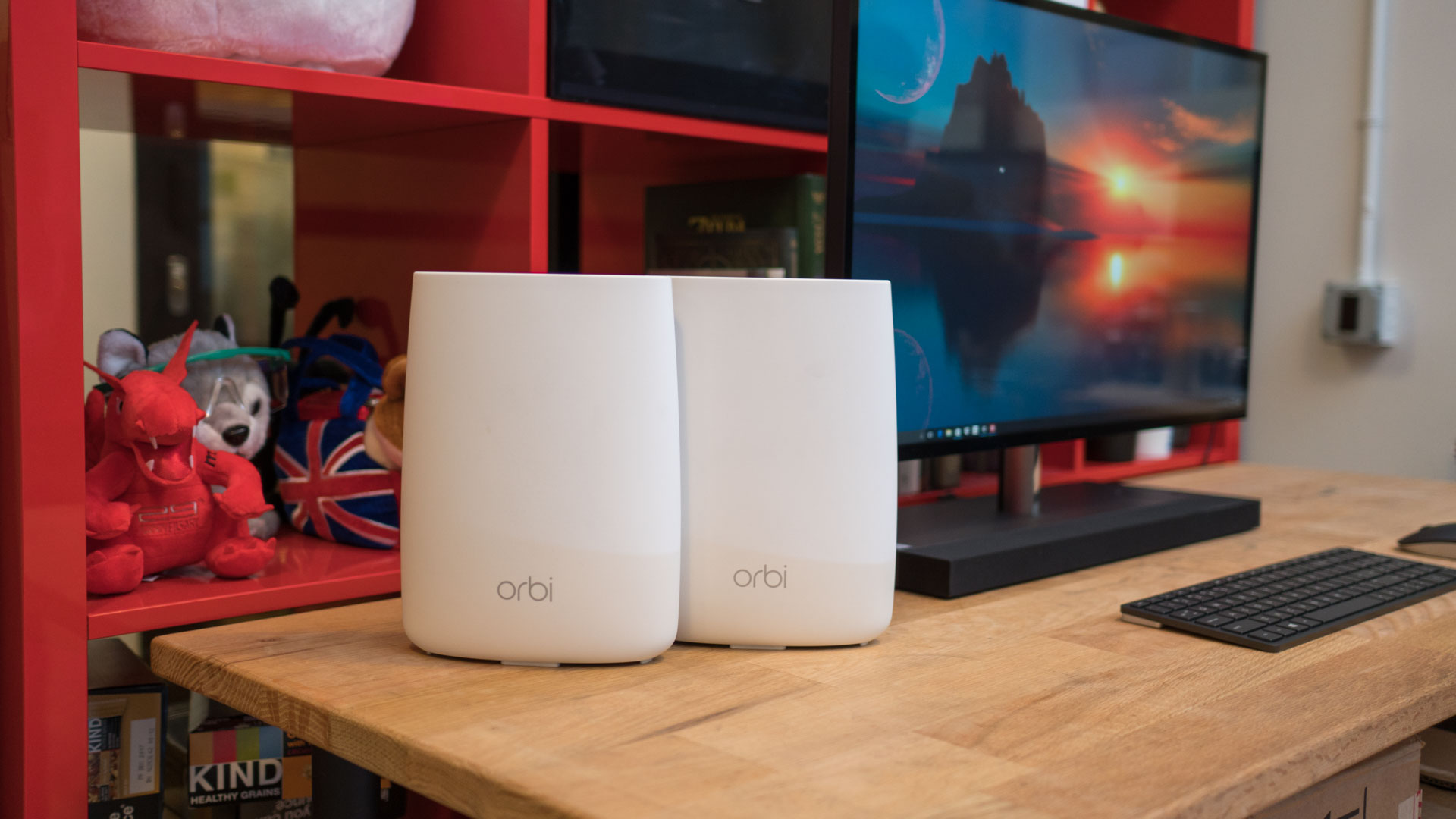TechRadar Verdict
Unimpeded, seamless Wi-Fi coverage throughout your house isn’t just possible with Netgear Orbi, it’s easy as pie, but that convenience will cost you dearly.
Pros
- +
Excellent coverage
- +
Easy setup
- +
Approachable design
Cons
- -
Mighty pricey
- -
Finicky Wi-Fi band settings
Why you can trust TechRadar
Sometimes, no amount of prime router placement can get you decent Wi-Fi coverage throughout your house. Netgear isn’t the first to try and solve this problem, but its new Orbi Wi-Fi system tackles it pretty handily.
Comprised of one Router device and one (or more) Satellite device just like the more popular Google Wifi, the Orbi system broadcasts an unimpeded Wi-Fi signal to every room in the house. It sounds like an empty promise from a 2am infomercial, but we can gladly report that Orbi can do exactly what it says on the tin.
Price and availability
Being more than your traditional router, a Wi-Fi mesh system, try not to suffer too much sticker shock after seeing the Netgear Orbi’s $399 (£399, AU$749) price tag. Available now in the US, UK and Australia, one Orbi box comes with both the “Router” unit and one “Satellite” unit, hence the added cost.
More Satellites can join the mesh system for an additional $249, £249 or about AU$329 apiece – so, your bill can rack up quickly, depending on your home size. One system is said to cover 4,000 square feet or 370 square meters.
Regardless, the Orbi is still mighty expensive compared to your average router. So, how well does Netgear Orbi justify its price? Pretty damn well, actually.

Wireless Connectivity: Tri-band 802.11a/b/g/n/ac (802.11b/g/n at 2.4GHz, 802.11a/n/ac at 5GHz); AC3000 (1733 + 866 + 400Mbps); MU-MIMO capable
Memory: 512MB RAM
Storage: 4GB Flash
Beamforming: Implicit and Explicit for 2.4 & 5GHz bands
Ports: 4 x 10/100/1000Mbps Gigabit Ethernet ports (1 WAN + 3 LAN for Router, 4 LAN for Satellite), 1 x USB 2.0 port
Dimensions: 6.67 x 2.36 x 8.89 inches (16.9 x 5.9 x 22.5cm; W x D x H) each
Weight: 1.96 pounds (889g) each
Design and setup
While it’s referred to as a single product, Netgear Orbi is technically comprised of two parts: the Orbi Router and the Orbi Satellite. Both 1.96-pound (889g) devices are nearly identical, adorable pylons of white matte plastic.
Their only differences lie in which ports are included in which unit, and the Router sporting a blue top versus the Satellite’s pure white.
Sign up for breaking news, reviews, opinion, top tech deals, and more.
On the back, the Router houses a Sync button (more on that in a moment), three Ethernet LAN ports (for connecting other internet devices), one Ethernet WAN port (for your gateway or modem connection), a USB 2.0 port for network-attached storage and a standard DC power port. The Satellite has all of this, but swaps that WAN port for a fourth LAN port.
Even without the Orbi app available for iPhone and Android, setting up what Netgear calls the Orbi’s “Tri-band Mesh” system is surprisingly simple. Netgear has more specific instructions, but setup basically amounts to connecting the Orbi Router to power and your modem or gateway, then positioning the Satellite in a more central location in your abode and connecting it to power.

Then, after pressing the “Sync” button on each, the two devices will begin to communicate, and that’s when the magic happens. Underneath those separated plastic lids are LED rings that illuminate in different colors and pulses to indicate how their connection is doing.
A solid blue ring indicates a strong, stable connection, an amber ring details a “fair” connection (i.e. move the Satellite a bit closer) and a magenta ring indicates a poor connection (i.e. move it a lot closer).
Finally, you log into the Orbi system’s settings via your browser, to “orbilogin.com” with the information on the bottom of the Router, and set up your SSID. From there, your home should be covered in Wi-Fi that gives off the same speeds from floors or walls away as it does from within five feet of your router.
Here is how the Netgear Orbi fared in our brief suite of tests (conducted on a 100Mbps service):
MegaPath Speed Test Plus 5GHz (Download | Upload):
Within 5 feet/1.52m: 90.14 | 105 Mbps
Within 13 feet/3.96m; three plaster walls: 98.2 | 107.67 Mbps
MegaPath Speed Test Plus 2.4GHz (Download | Upload):
Within 5 feet/1.52m: 93.69 | 109.4 Mbps
Within 13 feet/3.96m; three plaster walls: 100.58 | 95.8 Mbps
1.5GB Steam download 5GHz (peak speed):
Within 5 feet/1.52m: 12.6 MB/s
Within 13 feet/3.96 meters; three plaster walls: 12.5 MB/s
1.5GB Steam download 2.4GHz (peak speed):
Within 5 feet/1.52m: 10.23 MB/s
Within 13 feet/3.96m; three plaster walls: 8.8 MB/s
Performance
So, how good is that sphere of glorious Wi-Fi? Pretty remarkable, to be honest. While the house that the Orbi was tested in is a mere 1,100 square feet, the difference between this and our stock gateway courtesy of Verizon is night and day.
Before installing the Orbi system, streaming anything via Amazon Fire TV in the living room from the office-bound router was a stilted experience with buffering aplenty. And, forget trying to get much done from the finished basement.
With the Orbi replacing that router and a Satellite in the living room, those problems are 100% eliminated. We can even stream Netflix in 4K resolution to a Roku 4 in the finished basement with no buffering at all. (That’s through three walls of plaster and a cinder block crawlspace, mind you.)
How does this work? The Orbi Router and its Satellite broadcast three distinct bands of Wi-Fi signal: one at 2.4GHz and another at 5GHz, and then another 5GHz band that’s locked off from normal access.
It’s through this second, hidden 5GHz band that the Router delivers its Wi-Fi signal to the Satellite(s) and back, and thus doesn’t take up the same bandwidth being used by your various devices.
For as wondrous as it sounds (and truly is), this system comes with two small caveats. For one, Orbi broadcasts both Wi-Fi signals under a single SSID and will switch between them on a per device, per location basis to maintain a consistent experience.

For most, this will come as a wonderful convenience; but, for those that like a bit more control over their Wi-Fi use, it can quickly become a pain.
Our attempts to isolate either band from within the Router’s settings, to properly benchmark the Orbi, ended up with us unable to connect at all from a laptop with both bands enabled. This is easily solvable on a Windows 10 device by tweaking your Wi-Fi radio via Device Manager, but Orbi doesn’t seem to like you trying this within its own settings, despite allowing for it.
Second, should you lose power or accidentally unplug either the Router or a Satellite, getting both products to operate normally again is tougher than it should be. Whether it’s getting the two to sync up again or for the connected devices in question to recognize the network, it’s a hassle to the point that hard-resetting both devices with their pin-sized “Reset” buttons might be faster.

Final verdict
All told, we found the Netgear Orbi to be an incredible solution to our Wi-Fi woes at home – so much so that we’re dreading having to send this unit back. While it’s probably twice as expensive as any router you’ve ever bought, the Orbi’s benefits do well to justify the price.
For those that own large houses, or even small houses or apartments with thick walls, the Netgear Orbi can coat your whole property in consistently strong Wi-Fi signal. After seeing what Orbi can do, we’re going to have one helluva hard time going back to a crummy gateway.
- Check out our Netgear discount codes to get the best deals on Netgear products.

Joe Osborne is the Senior Technology Editor at Insider Inc. His role is to leads the technology coverage team for the Business Insider Shopping team, facilitating expert reviews, comprehensive buying guides, snap deals news and more. Previously, Joe was TechRadar's US computing editor, leading reviews of everything from gaming PCs to internal components and accessories. In his spare time, Joe is a renowned Dungeons and Dragons dungeon master – and arguably the nicest man in tech.
